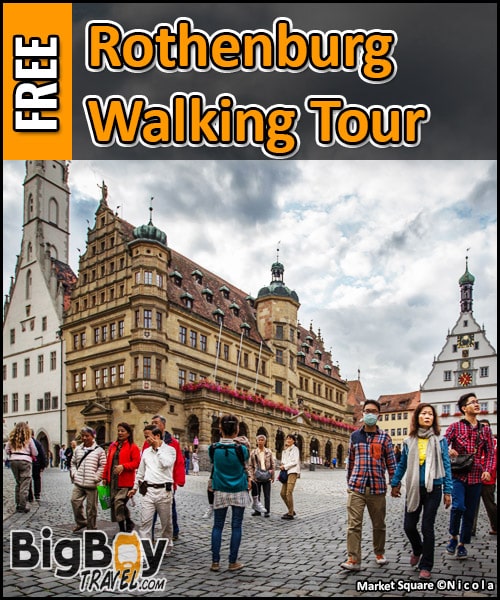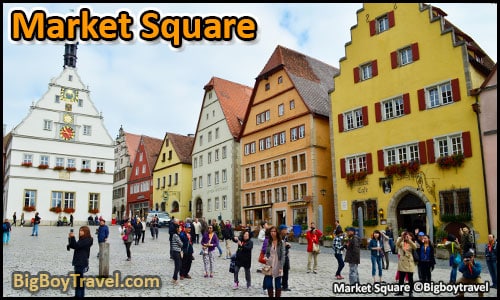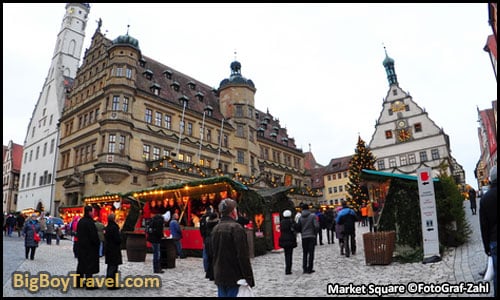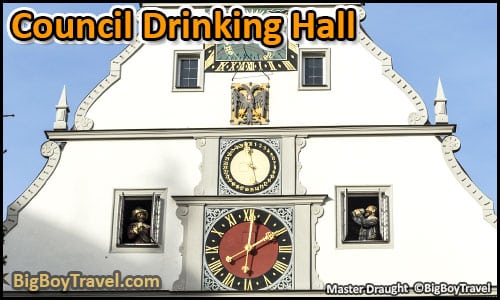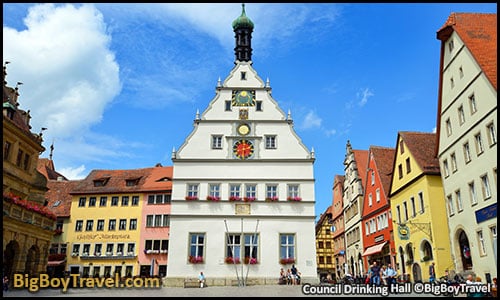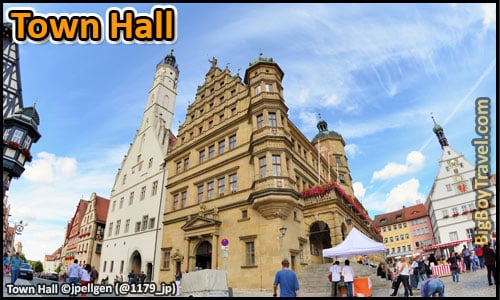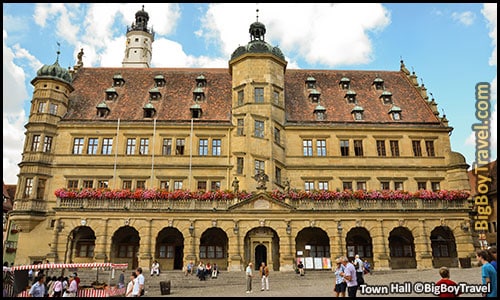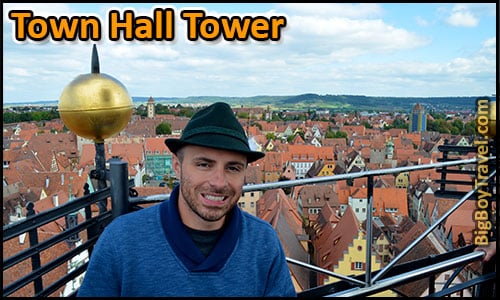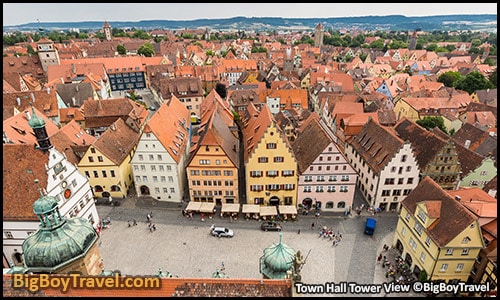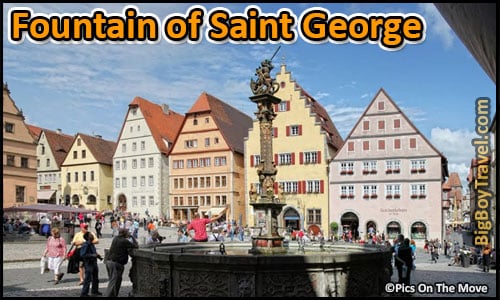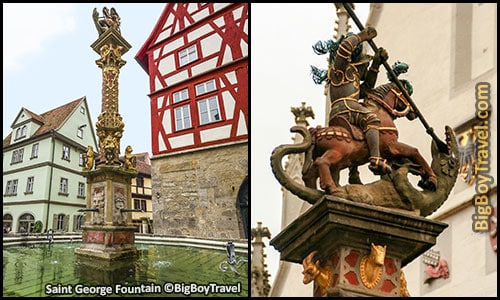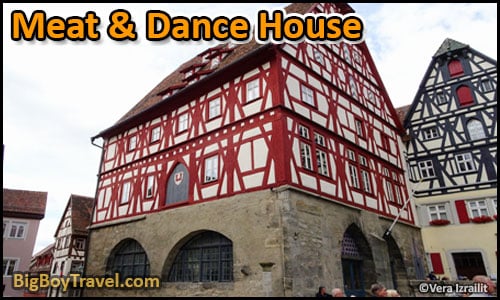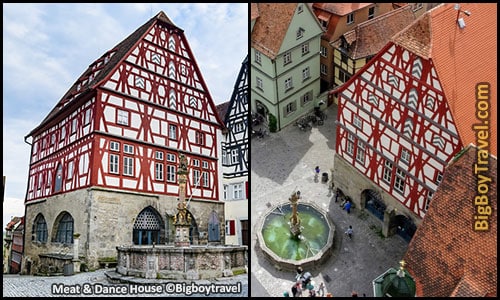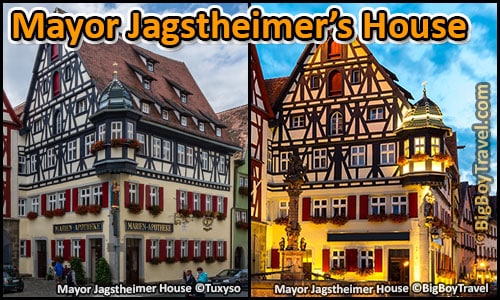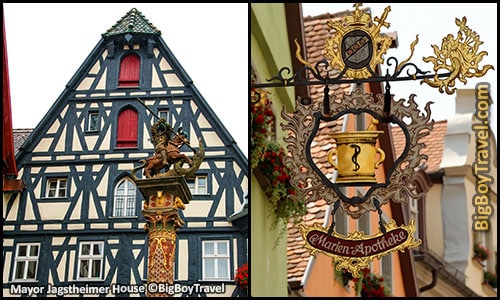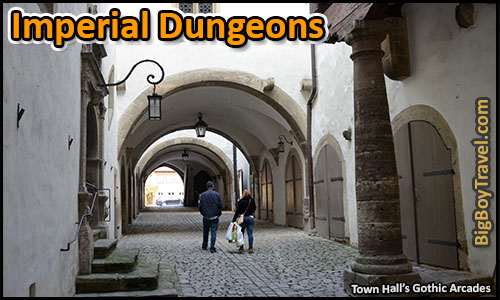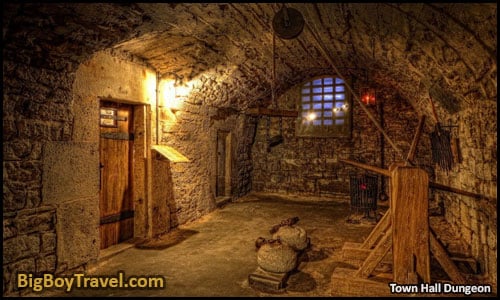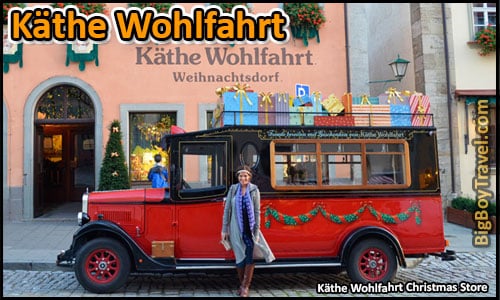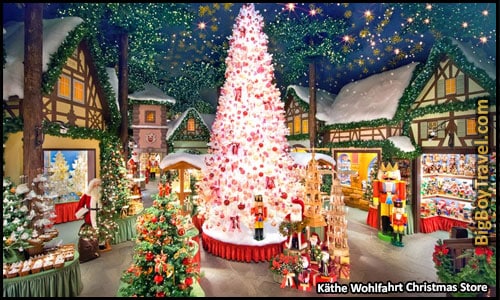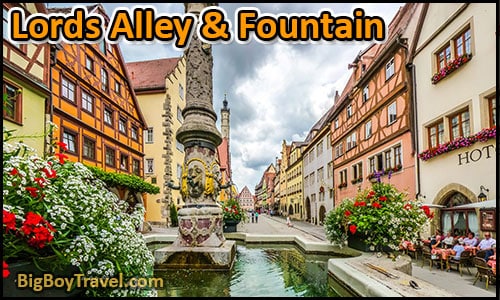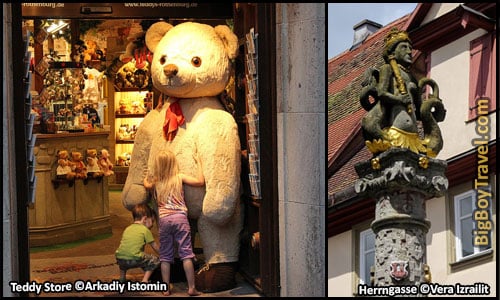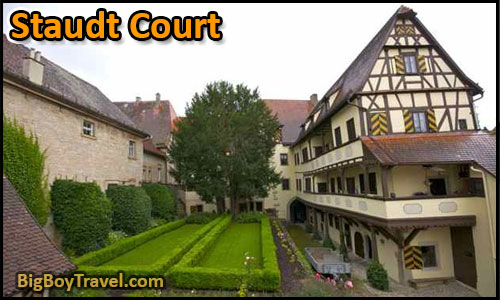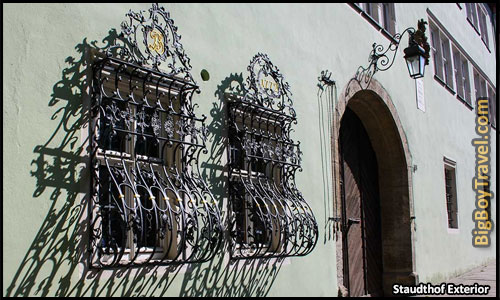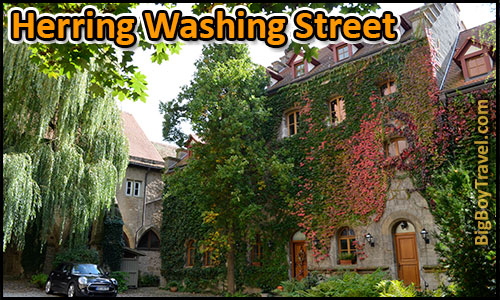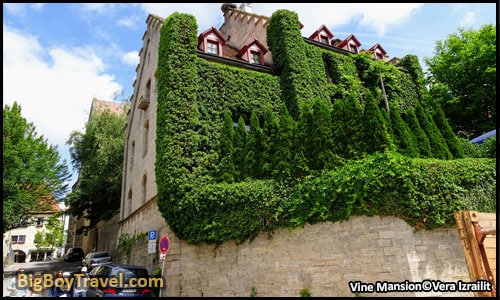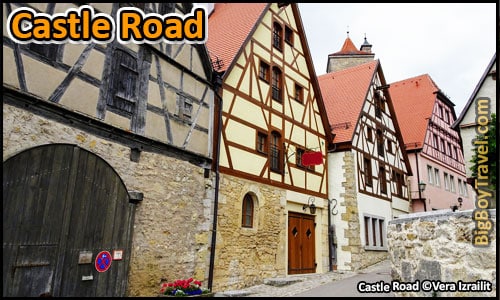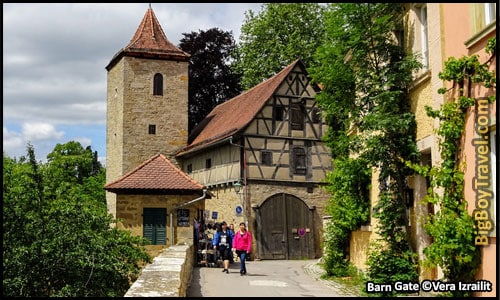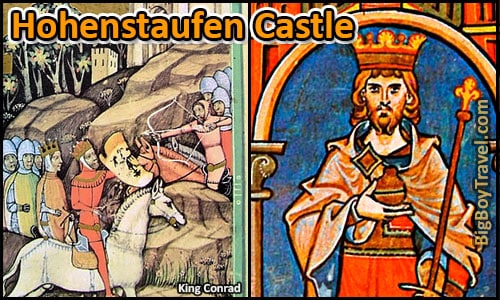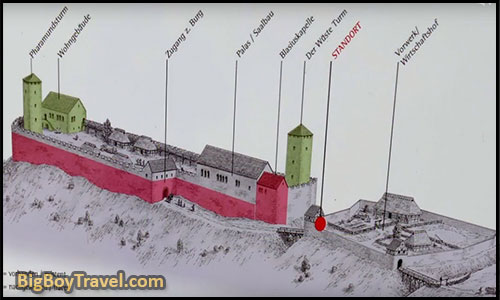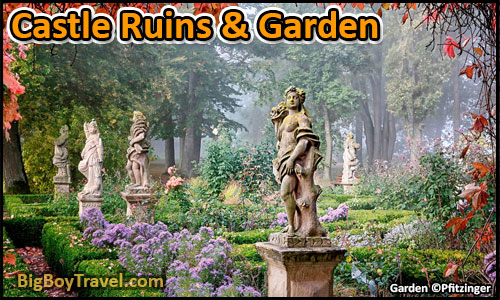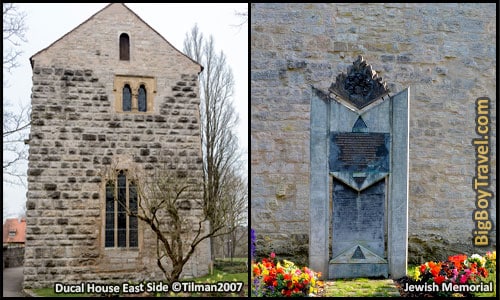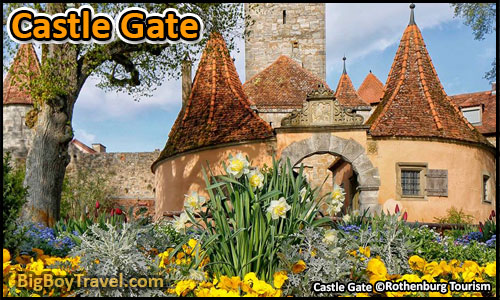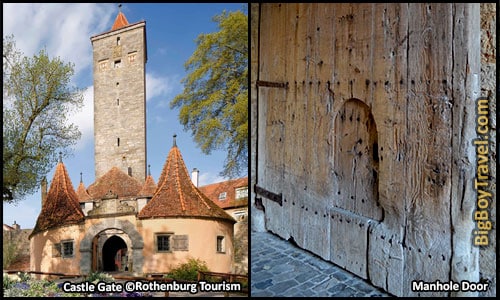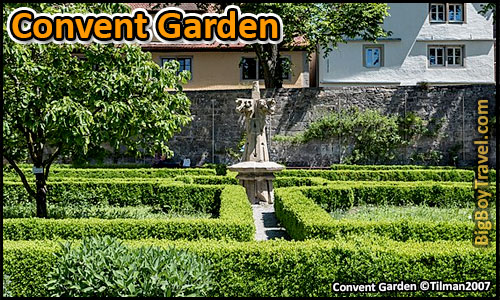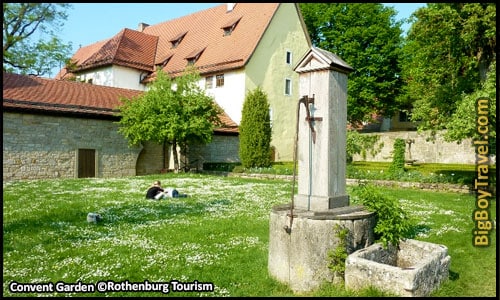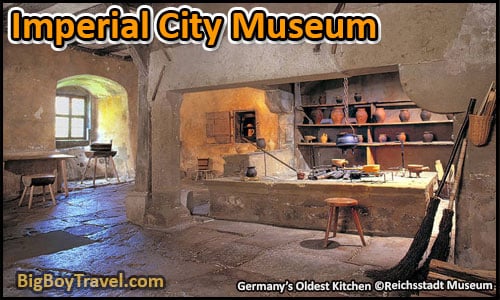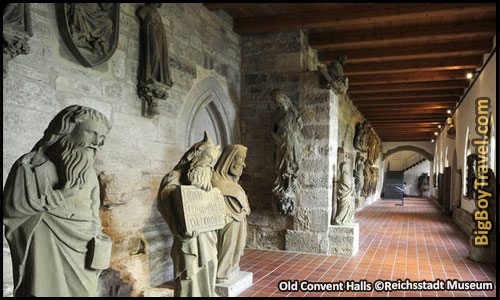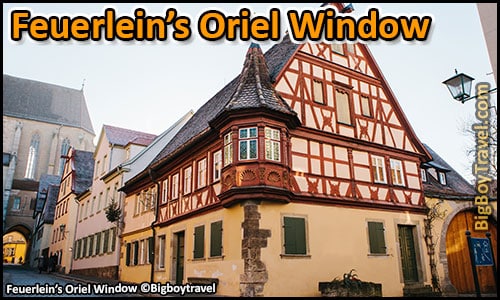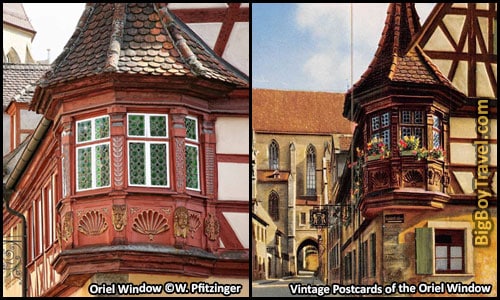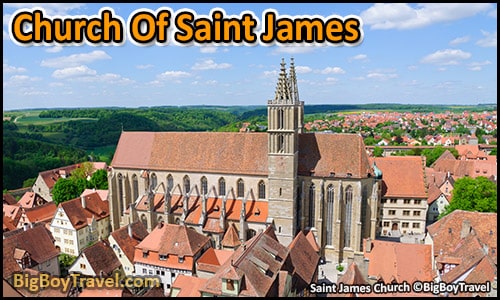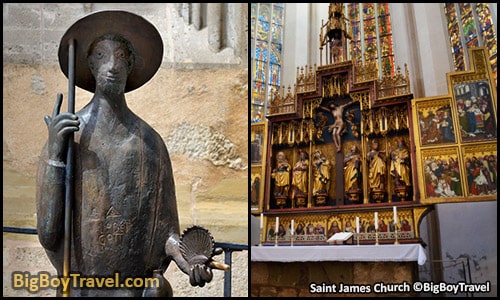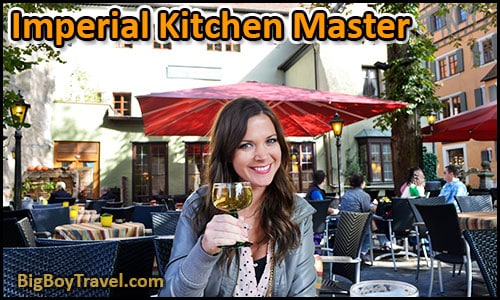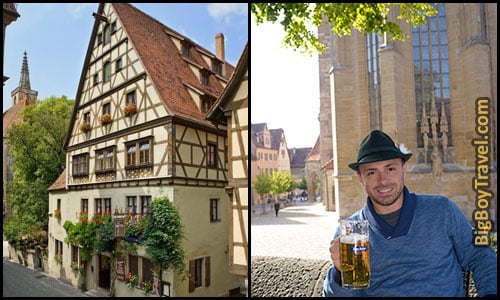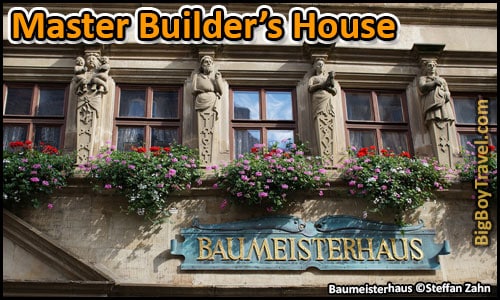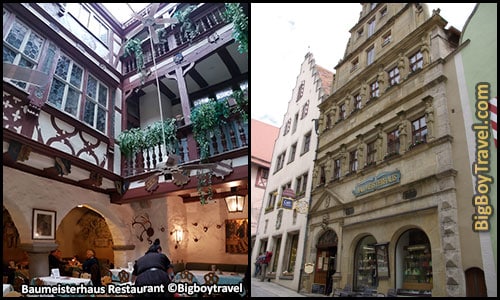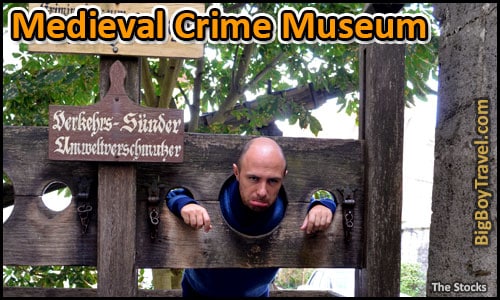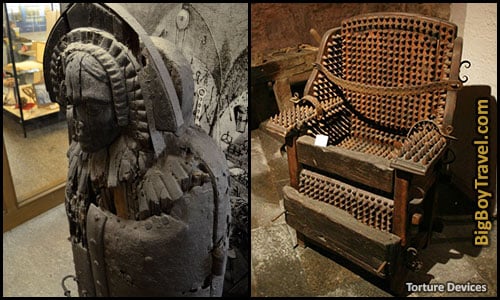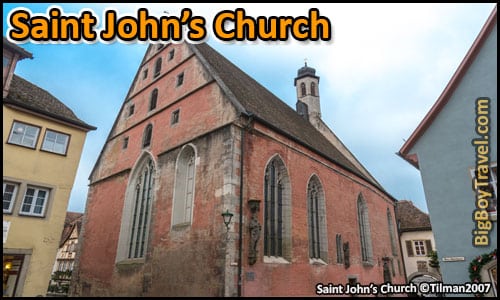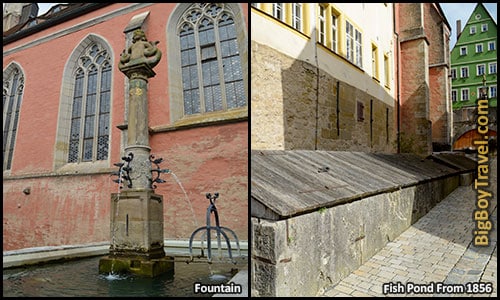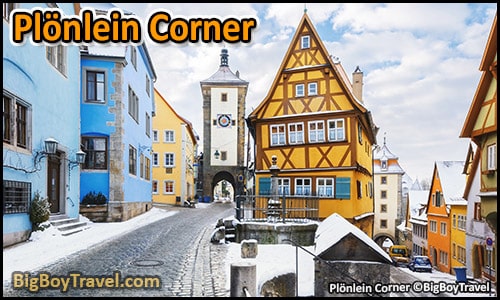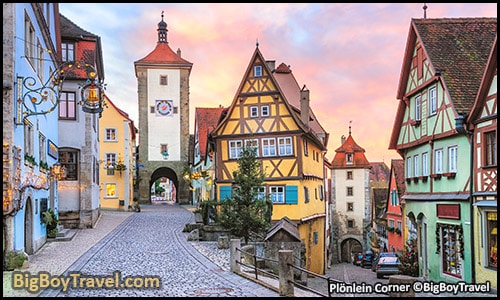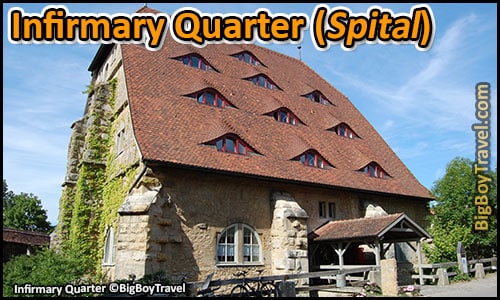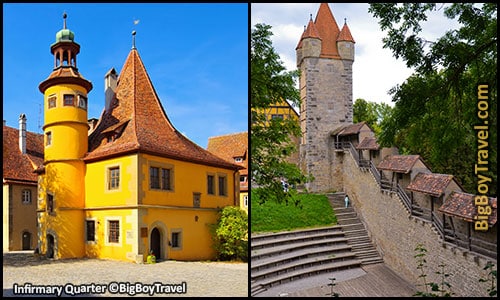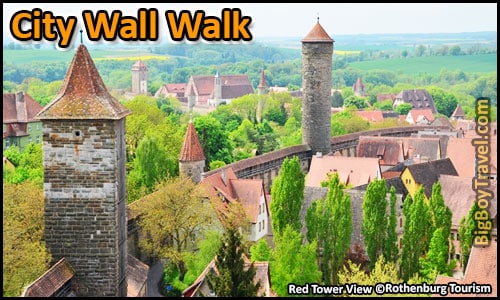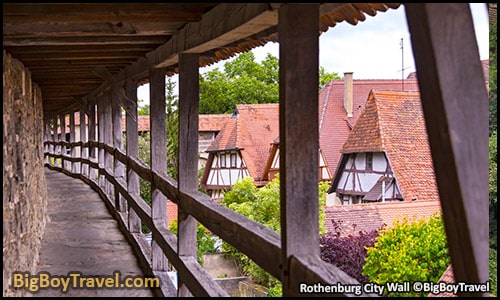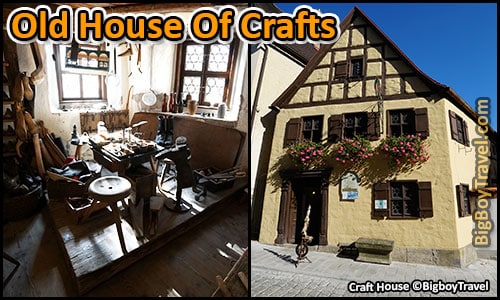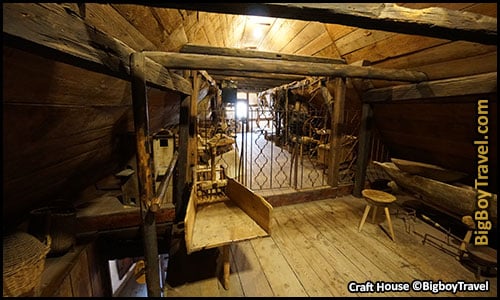Free Rothenburg Walking Tour:
Walking Tour Location: Old Town Rothenburg
Cost: Free, Self-Guided (Museum and funicular/lift costs below)
Style: Do-It-Yourself Walking Tour (Self Guided)
Start: Market Square (Marktplatz)
End: Plönlein Corner
Walking Distance: 1.1 miles (+0.6 miles for Infirmary Quarter; +0.6 miles for short wall walk)
Time Required: 60 Minutes for Walk (2-3 hours with sights; +1 hour for each of the 3 museums; +0.5 hours for Infirmary Quarter)
Fun Scale: 10 out of 10
Overview of Old Town Rothenburg:
Spending a day in Old Town Rothenburg (Row-tin-burg, with a rolled R) is like stepping 400 years into the past. This time capsule of a Franconian village is packed with colorful half-timber homes, old-world sights, cobblestone lanes, and is surrounded by a medieval city wall. The pure beauty of Old Town is Rothenburg’s main attraction, but when you mix in the Night Watchman tour, the Christmas market, and great year-round shopping you have the makings for an unbelievable visit.
We highly suggest spending at least one night in Rothenburg as it feels truly magical in the evening after the tour buses have left. Our self-guided walking tour map below covers all the must-see attractions with plenty of opportunities to get away from the mid-day crowds. If you have extra time, you can also walk along the City Wall tour (Turmweg) or bike down to the river which gives the city its full name Rothenburg ob der Tauber (meaning Red Castle over the Tauber River). Rothenburg is definitely a place to take your time, relax, and enjoy. We hope you enjoy our self-guided Old Town Rothenburg walking tour map!
Rothenburg Walking Tour:
1. Market Square (Marktplatz):
About Market Square: Shortly after King Conrad III of German (House Hohenstaufen) built his royal castle in Rothenburg in 1142, a village began to grow around it. Traders quickly started selling their goods and produce and Market Square was born. As Rothenburg gained official market rights in 1172, the main square became the center of both trade and social life in the town.
Since Rothenburg sat on two major Medieval trade routes, it gained Free Imperial City status in 1274 by Rudolf I King of Germany (Habsburg Dynasty). The village quickly grew to be the 2nd largest city in Germany in the year 1400 behind Cologne, and the vast Market Square truly blossomed. Rothenburg’smain square became the host for the town’s biggest festivals along with some of the most impressive colorful mansions and half-timber houses. If you are looking for a bite to eat in the square, we recommend the Ratstube Restaurant whose tables spill out onto the square during nice weather. The restaurant also has a secret dining room down in their medieval cellar we feature on our Top 15 Hidden Gems of Rothenburg.
In addition to the festivals, there were also numerous historic events that happened in Market Square. In 1474, Holy Roman Emperor Friedrich III had a massive feast in Rothenburg’s main square, where he symbolically gave King Christian of Denmark the German state of Holstein to pledge an alliance. A more gruesome event happened in Market Square in 1525 when Count Casimir von Ansbach had 17 leaders of the recently defeated Peasants’ Revolt publicly beheaded here and left to lay in the street all day.
The 30 Years War is what frozen Rothenburg in time and over each of the 7 times the city was occupied (1631-1645) the homes on Market Square had to harbor alternating hoards of both enemy forces (Catholic) and allied troops (Protestant). During one of the occupations in 1632, the Protestant King of Sweden Gustavus Adolphus (Gustav-Adolf) stayed along Market Square just 49 days before being killed in battle.
2. Council Drinking Hall (Ratstrinkstube):
About The Council Drinking Hall: Built prior to 1446, the huge Council Drinking Hall was once a very exclusive tavern that could only be entered by city council members. In order to be on the city council, you had to be born into a noble-class patrician family making it very limited.
With the Medieval government long gone, today all the action at the Council Drinking Hall happens on the outside of the building’s beautiful facade. On the front of the hall is a centrally placed modern clock (installed 1638), a calendar date clock, and a sundial (1768) above the black double eagle coat of arms from the Holy Roman Empire. The former tavern building also holds the local tourism office and one of the only ATMs on our self-guided Rothenburg walking tour.
At the top of every hour from 10am-10pm, you have to keep an eye out for the special show that happens on the front of the Council Drinking Hall called legendary Master Draught. The small windows flanking sides of the clock open to reveal hidden mechanical figures which reenact a famous story from Rothenburg’s history.
Folklore says that in 1631 Mayor Nusch (Nu-sh) saved the Protestant village from destruction at the hands of the troops of Catholic General Tilly during the 30 Years War. The legend is that the famous mayor won a wager for Rothenburg’s fate by drinking over 3 liters of Franconian wine in one gulp known as the Master Draught. The truth of the story is that General Tilly and his 40,000 troops occupied the village for the entire Winter before leaving, badly depleting Rothenburg of its food reserves.
3. Town Hall (Rathaus):
About The Town Hall: After the Old Town Hall located at today’s Meat & Dance Hall burned in 1240, construction on a new huge Gothic-style Town Hall (Rathaus, pronounced Rat-house) started here in 1250. The new block-long Town Hall was much larger than the old one as it covers the entire length of Market Square. The design was also very different as it was the new complex was made up of two massive parallel halls with entrances onto Herrngasse Street, a soaring bell tower, and built-in market stalls facing the main square.
Like the Old Town Hall, the new Gothic Town Hall also had a brush with fire in 1501 when the front half of the building facing Market Square burned down. Luckily, the back half of the building, the watchtower, and the vaults survived the fire. You can see a painting of the Town Hall from 1466 before the fire HERE which you can see in person later on this walking tour at Saint James Church.
Since it had been over 250 years since the Gothic Town Hall was built, they decided to rebuild the damaged front in a more modern Renaissance-style instead. The rebuild spanned some chaotic years in Rothenburg and was a huge project that wasn’t completed until 1572 which included a new entrance facing Market Square. The New Town Hall was so impressive for its day, that it was considered the most imposing example of Renaissance architecture north of the Alps for almost a decade. While they functioned together, the white back half of the complex became known as Old Town Hall and the yellow front half became known as New Town Hall.
The Baroque-style street-level arcade and full-length porch further expanded the front of the Town Hall in 1681. We love the coat of arms for the seven Holy Roman Empire Electors decorate the arches of the arcade. Notice how the left side of the gallery has 13 steps, but as you look to the right the steps gradually disappear into the pavement? This is because Market Square is actually quite slopped and the new stairs spanning the length of the building needed to account for the angle.
If you look up at the angles of the windows in the short center tower on the front of the Town Hall you can follow the path of the staircase spiraling inside it. The surrounding windows on the facade are also used as a living Advent Calendar during the annual Christmas Market. We will visit the much taller belltower on the white back half of Town Hall next on our free walking tour of Rothenburg.
4. Town Hall Tower (Rathausturm):
About The Town Hall Tower: The surviving back part of the Gothic Town Hall remained white, but got a Renaissance upgrade to its bell tower. The 170-foot-tall tower provided better communication with the city watchtowers, and today you can still climb the 220 steps for the best views in Rothenburg.
One of the more interesting things about Rothenburg’s Town Hall Tower is that it was built without its own ground-level foundations. This means that the tower basically rests on top of the building’s roof gable thanks to some perfect enginering. While the vaulted passageway under the tower is stunning, the entrance to climb the bell tower is on the front of the building complex facing Market Square.
Tower Hours: January-March & November Saturday & Sunday Noon-3pm; April-October Daily 9:30am-12:30pm & 1-5pm; During the Christmas Market 10:30am-2pm & 2-6pm (8pm Friday & Saturday). Cost: Adults 3€; Kids 1.50€. Entrance: To begin your climb to the top of the white bell tower you will need to enter the main door on the front of the yellow part of the Town Hall facing Market Square.
5. Fountain of Saint George (Sankt Georgsbrunnen):
About The Fountain of Saint George: Sitting over the 8-meter-deep Herterich’s Well is the beautiful Fountain of Saint George. Water wasn’t always easy to come by in Rothenburg even though it is by the Tauber River because the village sits upon a rocky ridge. An underground canal system was built in 1418 to keep the Rothenburg’s 40 public wells stocked with outside water in case of drought or war. The new water table reservoir system in the village also provided allowed 300 of Rothenburg’s roughly 800 homes to get their own private wells.
As part of a series of building projects in 1446, a free-flowing fountain was added over Herterich’s Well to give some elegance to Market Square’s main communal water source. In front of the green home (Marktplatz #8) near Herterich’s Well sat the gallows, pillory, and hangers where people were executed or tortured on public display. There was even a second smaller well at the pillory where bakers would be dunked underwater (Bäckertaufe) as punishment to starve them of their oxygen during times of famine as the city starved.
The Renaissance-style central column was added to the Herterich’s Well Fountain in 1608 and is capped by a figure of an armored Saint George on horseback famously slaying a dragon. The addition of Saint George ultimately changed the name as the fountain was officially dedicated to him. This image of the victorious knight defeating darkness is a very common scene in Medieval art often as a symbol of man overcoming the plague.
If this wonderful fountain looks familiar to you, that may be because it was featured in the 2017 version of Walt Disney’s Beauty and the Beast. A fully life-size replica of Rothenburg’s Saint George Fountain was built on the London set for the filming of the movie. The Saint George Fountain was also recreated for the German Pavilion at Epcot Center. We pass by a few other spots that inspired scenes from Disney movies along this free Rothenburg walking tour and we also highlight them on our 15 Hidden Gems of Rothenburg guide.
6. Meat & Dance House (Fleisch und Tanzhaus):
About The Meat & Dance House: The gorgeous half-timbered home behind the Saint George Fountain known as the Meat & Dance House is one of our favorite homes in Rothenburg. As King Conrad III (House Hohenstaufen) built his royal castle at the other end of Herrngasse Street in 1142, a village started to with a large building here that served as his Royal Court (Am Hof). Representatives from as far away as Rome and Byzantium would come here to hold court with Conrad, the King of Germany, who was destined to be the Holy Roman Emperor if it wasn’t for his untimely death.
After King Conrad’s last son die without an heir in 1167, the former royal court became Imperial property. Holy Roman Emperor Federick Barbarossa (Conrad’s nephew) gave the village city & market rights in 1172 and this building became Rothenburg’s 1st town hall. Not only was the Old Town Hall (Altes Rathaus) where the noble city council would meet but was also where the local market was managed.
Unfortunately, the Old Town Hall burned down in 1240, but the magnificent half-timbered building you see today was completed on the original foundation in 1270. With tall vaulted ceilings, the upper level was used as a dance hall for parties and celebrations. The first floor was an open shop for local butchers to sell their meats.
Today, the upper level of the house is used to store colorful costumes that the city uses in annual festivals and historic reenactments. The lower level is now home to the Artist Union which sets up various art galleries. Prior to 2014, the house was painted in dull tan-colored tones and we love that they brought back the bright red and white which are Rothenburg’s official colors. If you go around the backside of the Meat & Dance House you can see the Romanesque Royal Fountain (Hofbrunnen) which was also part of King Conrad’s royal court. As you look at the side of the building make sure to look at the covered live fish storage container.
7. Mayor Jagstheimer’s House (Jagstheimerhaus):
About Mayor Jagstheimer’s House: As one of the most beautiful historic homes you’ll see in Europe, this huge half-timber Jagstheimer House mansion has roots in early-day Rothenburg. As Rothenburg gained the rights to form a noble city council in 1172, they built a new home for the mayor right next to the Old Town Hall (today’s Meat & Dance House).
Based on excavations on the narrow foundations visible in the basement, we know the first version of the Mayor’s home looked very different than you see it now. It had a narrow stone lower level which was built up like a tower and likely resembled the top-heavy Toppler Water Palace (photo) in the Tauber River Valley. The Mayor’s house was also burned in the Fire of 1240, but the half-timber upper floors were repaired. One interesting thing about the repairs from the fire was that an underground tunnel was built (or at least planned) connecting the Mayor’s house to the new Gothic Town Hall across Herrngasse.
Hans Jagstheimer (yags-time-ahr) bought the mayor’s house in 1479 and completely re-built it as you see it today in 1488. Jagstheimer was no stranger to construction as he served on the City Council as the regional Builder Master (Äußere Baumeister) from 1481 to 1493 and even spent time as the mayor. The main feature that literally stands out on the Jagstheimer House is the 2nd story oriel-style bay window sticking out of the corner of the mansion. Surprisingly the home is mansion-sized as stretches back far off of the main road all the way past the former Royal Court (Am Hof) and has a delightful inner courtyard. Over the years the stately home hosted numerous prominent guests including Emperor Maximilian I in 1513, who also visited Rothenburg as a teenager. The Jagstheimer family continued to live here for 4 generations until the last heir passed away in 1571.
Georg Nusch, Rothenburg’s most legendary mayor also lived at the Jagstheimer House after marrying the widowed owner in 1617. At the time she (Maria Salome, b. Schnepf) was 46 and Nusch was only 28. Nusch was well educated and quickly joined the City Council as he also came from a local patrician family. His father was the owner of Rothenburg’s Red Rooster Guesthouse (Hotel Roter Hahn) which first opened in 1380.
As the 30 Years War approached Rothenburg’s doorstep, Nusch grew vital in preparing the village for battle and his home became a hostel for visiting Dukes and high commanders. Having been elected mayor the year prior, Nusch was in charge when the Catholic forces under General Tilly breached the city walls and occupied Rothenburg in 1631. Folklore of the Master Draught says Nusch drank 3 full liters of wine in one drink to save Rothenburg from destruction although Tilly’s troops stayed in town for the entire Winter and ate most of the food reserves. During the war, Gustav Adolf (Protestant King of Sweden) also stayed at the Jagstheimer House for an evening (September 18th, 1632) just 49 days before he was killed in battle. Mayor Nusch died childless in 1668, but the home remained in his family until 1769.
The 1st floor of the Jagstheimer House has been home to the Saint Mary’s Pharmacy (Marienapotheke) since 1812. Johann Michael Schiller had been a pharmacist since 1785 at the struggling Mohrenapotheke (open since 1600) in Market Square, then bought the Jagstheimer House to expand out on his own. The image of the Virgin Mary was already below the Oriel window making the name an easy fit. We love the Medieval-style wrought iron business sign at the pharmacy which pays a nod to the when most people couldn’t read in the Middle Ages and relied on imagery to identify businesses.
Address: Marktplatz #10.
8. Imperial Dungeons:
About The Imperial Dungeons: You can also visit 8 of the vaults of the historic Imperial Dungeons to get an idea of the prison conditions in the 1500-1600s including The Thirty Years War. Exhibits include a guardhouse, a torture room, and three jail cells. The entrance to the Imperial Dungeons is inside the gothic city hall atrium hallway and is accessible on the southside of the building along Herngasse.
Prior to the Town Hall vaults being used as a prison, criminals were also kept in other smaller jails inside some of the sections of the city wall. These locations included the Marcus Tower (1204) which has 10-foot-thick walls and the Rotten Tower (1385) which housed serious criminals.
Heinrich Toppler, Rothenburg’s most famous Mayor, was imprisoned in the dungeon where he died in 1408 after being arrested by competing factions of the local nobility. Toppler had come from a wealthy patrician family which lived at today’s Gasthof Goldener Greifen and his dad was on the city council. Toppler married the daughter of another city councilman whose wife (Katharina Reinfrau) was the richest person in Rothenburg. After being elected Mayor by the council in 1373, Toppler helped Rothenburg boom by gobbling up neighboring towns and growing Rothenburg’s holdings to over 400 square kilometers. Toppler also led the city through rough times and is known for being just as he enabled laws to protect local Jews against organized massacres (pogroms).
The main drama started in 1400 when Mayor Toppler reached out to deposed King Wenceslas of Bohemia for military help against Ruprecht who had just power-grabbed the King of Germany (Romans) title. This angered local nobles even though Wenceslas had lived in Rothenburg as a boy at age 12 (1373) while his dad was Holy Roman Emperor. Toppler wasn’t re-elected in 1403 but continued to serve on the council. The whole thing eventually caused the Bishop of Würzburg to flip-flop alliances and joined Nuremberg in 1405 who attacked Rothenburg two years later. The city of Rothenburg withstood the 10,000 troop Siege of 1407 with ease thanks to Toppler’s planning but lost a lot of land holdings and the nobles never forgave him even though the city was prosperous.
On April 6th, 1408 the City Council had used Toppler’s wealth against him in public opinion and arrested him for stealing and he died in the dungeons on June 13th before being given a trial. Mayor Toppler is now beloved for having brought the golden age to Rothenburg and maybe the noble should have backed him as just 3 years later Ruprecht lost the King of Germany title to Wenceslas’ brother Sigismund (future Holy Roman Emperor).
Dungeon Hours: June-October Daily 9:30am-5:30pm; November-May Open Daily with times posts on a board at the entrance roughly 11am-4pm most days; Closed most of January. Cost: Adults 3.50€; Kids 2€. Dungeon Website: Here.
9. Käthe Wohlfahrt Store & Christmas Museum:
About Käthe Wohlfahrt: In a town famous for its Christmas Markets, Käthe Wohlfahrt (Kay-ta Vul-fhot) makes the holiday season last all year long. While they have 5 stores in Rothenburg, it is their headquarters that is the most impressive. Käthe Wohlfahrt is world-renowned for the quality of its ornaments and Christmas wears. The multi-level store is a full-on Christmas village with a teddy bear town and the largest collection of ornaments in Germany. Visiting really is special and will have you in the Christmas spirit the second you enter.
The 2,700 square foot German Christmas Museum (Deutsches Weihnachtsmuseum) sits above the store and covers hundreds of years of holiday history. The interesting exhibits have everything from Christmas trees, ornaments, holiday pyramids, Christmas cards, and more.
Käthe Wohlfahrt Website: (HERE). Christmas Museum Website: (HERE).
10. Lords Alley & Fountain (Herrngasse & Brunnen):
About Herrngasse: Connecting the Market Square to the former location of King Conrad’s royal castle is the prestigious street called Lords Alley (Herrngasse). The name Lords (Herrn) comes from the rich merchants who lived along the street in the Middle Ages. Because the lane is rather wide for a small Medieval village, it helped preserve the buildings as fires couldn’t spread as easily.
Today Herrngasse is still home to some of Rothenburg’s most stately homes and fancy shops. We will cover some of these stately homes next on this free walking tour, but it is important to look at the architectural details of the colorful buildings. We love the hayloft windows and pulley systems which used to bring goods to the upper floors of the homes for storage. The hayloft windows are covered more on our Top 15 Hidden Gems of Rothenburg guide. Two of our hotels in Rothenburg are also on Herrngasse including the Historic Gothic House (website) and Hotel Eisenhut (website).
Right in the middle of Herrngasse was the old cattle market which is marked today by the Lord Alley Fountain (Herrnbrunnen) added in 1595. The fountain got a Renaissance column makeover in 1615 (remodeled in 1722) with the mermaid statue to bless the water. The double fishtailed mermaid has a golden crown on her head and a golden scepter in her hand. The base of the column has blonde pig-tailed maidens spitting the water back into the fountain.
Each Spring this fountain is one of the main ones in Rothenburg that gets decorated with Easter eggs to bless the water. The hollow eggs that elaborately cover the Easter Fountains (osterbrunnen) are brightly painted and strung to form a beautiful garland. During the Imperial City Days Festival each September, the fountain is also where they demonstrate the Baker Baptism (Bäckertaufe) where bakers in Medieval times were dunked underwater as punishment during times of famine.
11. Staudt House & Courtyard (Staudthof):
About The Staudt House & Courtyard: This stunning home is one of the finest Medieval buildings in all of Rothenburg. The patrician home is double the width of its neighboring buildings and has a large inner courtyard laid out in the 1100s. Most of the current mansion was built around 1500 and it has had numerous famous guests since then. Holy Roman Emperor Charles V (reign 1519-1527, also King of Germany), German King Ferdinand I (Charles’ brother & successor), and Marie Eleonore of Brandenburg (wife of King of Sweden Gustav Adolf) all stayed as guests in this home in Medieval times.
The Czech Staudt family has lived here as the property’s owners since 1644. The interior is open for special tours which include the beautiful courtyard, former servants’ apartments, old stable, and the medieval kitchen. The hedges in the courtyard’s garden were planted in 1678.
Outside the home, make sure to check out the wide door which is big enough for a carriage to fit through. We also love the old chain doorbells hanging out front with 4 different chains to ring different parts of the home. The baroque window bars are from the year 1772. You can get a glimpse of courtyard life at the neighboring Kleines Cafe which is part of the Herrnschlösschen Hotel Restaurant Garden. The coolest thing about the garden at the cafe is that you can see a preserved tower house on the back of the building with a top wider than its bottom. It looks very much like the Toppler Water Palace (photo) and it what Market Square’s Jagstheimer House looked like before being rebuilt in 1488.
Address: Herrngasse 18.
12. Herring Washing Street (Heringsbronnengäßchen):
About Herring Washing Street: As you stroll down Lord’s Allery you pass the Franciscan Church (Franziskanerkirche) which is the oldest church in Rothenburg. It was built in 1285 (consecrated in 1309) as part of a monastery for the Knights of the Hinterland, a friary dedicated to the Virgin Mary.
The small fountain outside of the church was where traveling tradesmen in Medieval times would wash the sea salt off of their barrels and herring fish which led to the name of the cross street, Herring Washing Street (Heringsbronnengäßchen). The current stone fountain from 1784 (moved to West wall in 1872) has motifs of Rothburg’s Imperial City Crest and the lion emblem for the Counts of Comburg.
The Counts of Comburg may seem obscure today as they died out in 1116, but they built the small Vinegar Jug Castle in Rothenburg’s Infirmary Quarter in 1070. One year before the last Count of Comburg died, his daughter married the soon-to-be Duke of Franconia, Conrad III. The influential Conrad would later go on to be crowned the King of Germany (1138) and built his Hohenstaufen Castle in Rothenburg (1142) which sparked the development of the town (1170).
Further down Herring Washing Street (Heringsbronnengäßchen #2) is a massive ivy-covered mansion which is one of our favorite homes in Rothenburg. The vines not only cover most of the property’s large inner courtyard but also spill out over the outer wall. The building used to house the grammar school and housing for the Franciscan Church Monastery and was also a court prison. As you reach Castle Street (Burggasse) at the bottom of the hill, the ivy on the outer wall of the vine mansion is breathtakingly beautiful.
13. Castle Road (Burggasse):
About Castle Road: As you hit Castle Road you get your first view of the Tauber River Valley over Rothenburg’s city wall. Most of today’s Castle Road in the Middle Ages was part of the Saint John’s Monastery (established in 1200). Since the monks wanted to be separated from the general public to avoid temptation, a large part of the long alleyway was covered with a wooden roof and was closed to non-monks. The roof made the alley very dark, so it gained the nickname Hell Alley.
Playing off the street’s original nickname, our favorite restaurant in Rothenburg is called To Hell Tavern (Zur Höll). The restaurant sits in the oldest home in Rothenburg with a foundation dating back to 970. While small, the tavern has an authentic Medieval feel, one of the widest selections of Franconian wines in town, and a fantastic cave cellar room.
From Rothenburg, Castle Road was actually part of a 1200km trade route connecting over 70 castles that helped the early city prosper. In the East, the route extended through Nuremberg and Bamberg all the way to Prague. In the West, it went through Schwäbisch Hall and Heidelberg and all the way to the French border in Alsace. Known as the Thuringian Castle Road, it was also part of the middle route of the Saint James Way to France and brought an influx of pilgrims who called Rothenburg the Franconian Jerusalem.
Make sure to get a good view of the valley before entering Fürbringer Barn Gate (Scheunenturm) to see the former grounds of the royal castle. We will also visit the other end of Castle Road at the end of this free Rothenburg walking tour.
Zur Höll Hours: Summer Sunday-Thrusday 10am-9pm; Friday & Saturday 10am-11pm. Christmas Market Daily 5pm-10pm. Winter Monday-Saturday 5pm-10pm; closed Sundays. Restaurant Reservation Requests: info@hoell.rothenburg.de. Restaurant Website: (HERE).
Related Video: Tour Of Zur Höll Restaurant
14. King Conrad Hohenstaufen’s Castle:
About King Conrad’s Castle: The appendix-like park on the West side of Old Town Rothenburg was where Conrad III, King of Germany (House Hohenstaufen) built his royal castle in 1142. This castle led to the development of the surrounding town by 1172 and gave it the name Rothenburg ob der Tauber, meaning Red Castle over the River Tauber. As you walk through the Fürbringer Barn Gate (Burgtor), you enter what was formerly the walled farmyard (wirtschaftshof) which then connected to the fort-like castle by a bridge (see image). Conrad chose the location because the fertile land was cheaper than administrative centers like Bamberg or Würzburg, and also because he had close ties to the area.
In 1115, Conard III (House Hohenstaufen) grew roots in Rothenburg by marrying Gertrude, the daughter of Count Heinrich II von Comburg-Rothenburg. The Counts of Comburg (died out in 1116) oversaw parts of Franconia at the time from their court in Schwäbisch Hall and built the small fort known as the Vinegar Jug Castle (now gone) on the hill of Rothenburg’s Infirmary Quarter in 1080. Conrad also came from a powerhouse family as his dad was the Duke of Swabia (followed by his brother), his mom’s dad was Holy Roman Emperor Henry IV, his mom’s second husband was Margrave of Austria Leopold the Good (House Babenberg) who developed Kerms & Vienna, and his maternal uncle was Holy Roman Emperor Henry IV. Through his bloodlines, Conrad was directly related to all previous 18 Holy Roman Emperors going back to Charlemagne the Great and was destined for the throne himself.
Just one year after the wedding Conrad III was named Duke of Franconia by uncle Emperor Henry IV. Conrad was also named Prince-Regent for Germany along with his older brother Frederick I (Duke of Swabia). HERE is a map of the territories at the time to understand how much land the brothers were put in charge of. When Conrad’s uncle Henry IV died in 1125, his brother lost the appointment for King of Germany in surprise fashion to a distant cousin Lothair III (Duke of Saxony, House Welf) who leveraged Papal support. This was the start of the feud between the Guelphs (House Welf) versus Ghibellines (House Hohenstaufen) which would later spread in Tuscany and last over 100 years. After huge military defeats and the election of Lothair as Holy Roman Emperor in 1133, the brothers eventually had to acknowledge as their ruler.
Gertrude of Comburg had died in 1131 after giving Conrad three daughters so he re-married to Gertrude of Sulzbach in 1136, whose dad Count Berengar II of Sulzbach had founded Berchtesgaden in 1102. Conrad’s powerful brothers-in-law through the Berengar sisters gave him important allies including Prince Vladislav II of Bohemia (later King), Prince of Polish Ladislaus the Exile, and Byzantine Emperor Manuel I. With his bloodlines and new alliances, Conrad III was quickly elected King of Germany in Coblenz (March 1138) after Lothair died (December 1137), snubbing Lothair’s son-in-law and heir, Henry The Proud (Duke of Bavaria & Saxony, House Welf). Because Henry the Proud didn’t support him, Conrad striped Henry of the Bavarian duchy and gave it to his half-brother Leopold Leopold the Generous (House Babenberg) who also control the Margrave of Austria.
The newly crowned King Conrad III grew to be one of the most powerful men in Europe over the next 14 years and seemed destined for the Holy Roman Empire Crown which had sat vacant since Lothair’s death. Before leaving in 1147 with 20,000 troops to fight with Louis VII of France in the 2nd Crusade, Conrad III arranged for his two sons Henry Berengar (then 10 years old) and Fredrick IV (then 2) named Co-Kings of Germany (Prince Regent) with him in Regensburg to take over in case Conrad III died in battle. Conrad went on to participate in the ill-fated Siege of Damascus (1148) and returned to Germany.
His son Henry Berengar, who was once betrothed to the Princess of Hungary, was the winning general at the Battle of Flochberg (1150), but died later that year. Not long after, Conrad III also died on the 15th of February 1152 at Bamberg (buried at Bamberg Cathedral) of malaria. The title King of Germany then went to Conrad’s nephew Frederick Barbarossa (Emperor 1155-1190) who had fought with him in the 1st Crusade instead of his own six-year-old surviving son Frederick IV (1145–1167). The title transfer was a bit controversial as only Frederick Barbarossa and the prince-bishop of Bamberg were at Conrad’s deathbed to hear the order. Frederick IV was given his dad’s castle in Rothenburg and named the Duke of Swabia, but the Duke of Franconia title went to the Bishop of Würzburg.
Frederick Barbarossa was named Holy Roman Emperor in 1155 and Frederick IV took part in his cousin’s campaigns in Italy where he died from disease after occupying Rome in 1167 at the age of 21 and with no heirs. After Duke Frederick IV’s death in 1167, Conrad’s castle in Rothenburg was only lightly used. Emperor Barbarossa’s heirs produced three more Holy Roman Emperors and several Kings of Germany before the Hohenstaufen line died out in 1254.
The last Hohenstaufen King of Germany (Conrad IV) only stayed at Rothenburg Castle seven times between 1238 and 1251, then it sat mostly vacant as Imperial Property, and was eventually ruined by an earthquake in 1356. This event, known as the Basel Earthquake happened on October 18th and although it was estimated at a 6.0 quake the quake was centered 170 miles (273 km) away in Switzerland so it is hard to believe it fully ruined the Rothenburg Castle. It may have been damaged some, but it is more likely is that the dilapidated Imperial property which had been largely vacant for 100 years and partially burned in 1298 was pillaged for stone by the citizens to bolster the strengthening town.
15. Castle Ruins & Garden (Burggarten):
About Bruggarten: In 1356, Castle Hohenstaufen was said to have been ruined by a large earthquake (known as the Basel Quake). In reality, that quake in Switzerland was too far away to have done major damage but the castle had sat mainly vacant and unmaintained for over 100 years. In 1380, the Holy Roman Emperor Sigismund officially sold the dilapidated Imperial castle to the city and allowed much of the stone to be quarried to repair and bolster a growing Rothenburg’s fortifications. Quality stone was a precious commodity at the time and the 820 foot (250 meters) long and 130 foot (40 meters) wide former fortress had a lot of it.
In 1400, Mayor Toppler decided to rebuild the former castle’s Upper Ducal House into what is now the Chapel of Saint Blaise. As this royal castle didn’t have a chapel, the original Ducal House was connected to King Conrad’s private quarters and where he received guests during his visits. At the time of Toppler’s work, Rothenburg was the 2nd largest city in Germany at 6,000 residents and one of the 10 largest in the Holy Roman Empire.
Against the northside of the Ducal House, look for the stone Jewish Memorial from the Rintfleisch Massacre of 1298. At the time Rothenburg’s Jewish community lived along the outside of the original city wall, but had to seek refuge in the Hohenstaufen Castle for three days when a traveling mob arrived to kill them in religious persecution. With the help of local Christians, the mob burned and killed a majority of Rothenburg’s 500 Jewish residents including women and children. Before being stopped, the mob had ravished 146 communities in Franconia killing over 20,000 Jews. While parts of the old Jewish Quarter remain near the White Tower, the community was officially banned from Rothenburg in 1520. In more recent times, a second memorial was added inside the chapel for German soldiers who died in WW1 & WW2.
Roaming further down the former castle grounds, you’ll run into the orange Garden House (Gartenhaus) cottage which was once the main entrance into Hohenstaufen Castle. The cottage was built over the foundations of the ancient gatehouse in the 1600s and still incorporates the old Romanesque archway into its Eastern facing facade. Although not castles in the 1100s didn’t have pleasure gardens, the westside of the cottage has a lovely Baroque Castle Garden (Burggarten) in what was once the fortress’s main courtyard. The garden has beautiful geometric flower beds with 8 sandstone statues representing the 4 seasons and 4 elements. We love taking photos of the statues framed up with vines hanging from the wooden trellis tunnel. The garden is one of the best places in Rothenburg to relax, offering great views of the Infirmary Quarter skyline and the Tauber River Valley below.
As you reach the Western end of the former castle grounds you will even get to look down at Mayor Toppler’s unique top-heavy home along the river. This end of the castle had a watchtower and three-story manor house. A memorial stone was added in the Castle Park in 1908 honoring the 500 year anniversary of the death of the famous Mayor.
16. Castle Gate & Tower (Burgtor & Turm):
About The Castle Gate: While the Fürbringer Barn Gate along Castle Road was the original entrance to the castle, traffic naturally shifted to Castle Gate (Burgturm) which connected to the grounds to the Market Square. Following King Conrad’s death and infrequent Imperial visits over time, the castle eventually sat mainly vacant for over 100 years until Emperor Sigismund sold it to the city in 1390.
Although it is sometimes incorrectly attributed to an earthquake, the neglected castle was in disrepair and quickly became a quarry to enhance the walled defenses on the west side of the rapidly growing Rothenburg. This included super-sizing the Castle Gate (completed in 1460) by adding the town’s tallest wall watchtower, a drawbridge, and other protective measures. Two small gatehouses were built in front of the Castle Gate to help funnel in traffic, control customs, and thwart would-be attackers. To get a unique perspective on this stunning gate system, we like to look at it from the southside where you really get an amazing profile view of the former drawbridge.
A short distance after entering the Castle Gate you’ll see a decorative Pitch Nose Mask (pechnase) which has a mouth hole the guards would use to pour hot tar on attackers. Flanking each side of the mask, you’ll see two large vertical slots where chains were fastened to raise the gate’s small drawbridge. In medieval times, all of the city gates were locked at sundown so you would have to pay a fine at the gatehouse to get in after dark. You would also have to enter a special Eye-of-the-Needle Door with a miniature opening only big enough for one person at a time, known as the manhole. The current wooden manhole door dates back to 1555.
Read More: Rothenburg City Wall & Gate Tour
17. Former Dominican Convent Garden (Klostergarten):
About The Convent Garden: The Imperial Kitchen Master, Lupold von Nordenberg, funded a move to bring the local order of Dominican nuns to Rothenburg from the nearby village of Neusitz in 1258. The Dominican Convent complex had a large garden, a modest church, and dormitories for the devote nuns. While some of the convent’s wealth through donations much of it also came to the wedding dowry money they received from women who joined.
Although the Dominican Convent was dissolved in 1544 and the church was torn down in 1813, the rest of the grounds have been preserved as part of the Imperial City Museum. One of the main highlights of the museum is Germany’s oldest Medieval kitchen which dates back to the late-1200s. We will visit the museum in the former living quarters next on this free Rothenburg walking tour.
Even if you skip the inside of the museum, the Convent Garden is free to visit and one of the best hidden gems in Rothenburg. If you are looking to relax away from the hoards of mid-day tourists, this garden is one of the best green areas to do so inside the city walls. In the Convent Garden, they still grow 50 types of herbs, including a section of well-marked poisonous plants. While looking at the labels on the poisonous plants you can imagine their mixtures and wonder if they were used to heal or harm.
Hours: April-October Daily 8am-7pm. Cost: Free.
18. Rothenburg City Museum (Reichsstadtmuseum):
About The Rothenburg City Museum: Inside the dormitory building of the former Dominican Convent, the Rothenburg City Museum covers the history of the town’s time as a Free Imperial City (1274 through 1802). The enjoyable museum (opened in 1936) centers its attention around religious events and works but it also covers much more including Medieval weapons, historic sculptures, and Rothenburg’s best paintings. The Medieval Crime Museum, which we visit later in this walking tour, is the best museum in Rothenburg, but the Imperial City Museum is a very close second.
Our favorite exhibit in the Imperial City Museum is the impressive Medieval kitchen from the former Dominican Convent (started in 1258 and dissolved in 1544). The kitchen dates back to the late-1200s and is considered the oldest kitchen in Germany. One of the coolest parts of the kitchen is the Lazy Susan the nuns would use to give food to the poor visitors outside the convent without being seen.
In addition to all of the art and weapons, are two other exhibits that also really stand out to use at the Imperial City Museum. The first is the Jewish Heritage Room where you will find excellent displays with medieval ritual objects. There are also original preserved Jewish tombstones from the 13th & 14th centuries that were moved here from below the White Tower. You’ll notice the small pebbles placed on top of the tombstones which is an ancient practice originating from when stones were placed over shallow graves to stop the bodies from being exposed over time.
The second exhibit that really stands out is the completely preserved salesrooms of the former Saint George Pharmacy (1708-1991). While Saint Mary’s Pharmacy (1812-present) in the Jagstheimer’s House is the only remaining pharmacy in central Rothenburg, there used to be as many as 3 of them at a time on Market Square. There was Saint George which you see in the Imperial City Museum at Markt #10, the Mohren Apotheke (1600- late 1700s) at Obere Schmiedgasse #1, and the historic Löwen-Apotheke (1374-2016) on Marktplatz #3. They changed buildings and family ownership over the years, but along with the hospital in the Infirmary Quarter, the pharmacies were important to Rothenburg’s history.
Museum Hours: April-October Daily 9:30am-5.30pm; November-March Daily 1-4pm. Museum Website: (HERE). Museum Cost: Adults 4.50€; Kids Free.
19. Feuerlein’s Oriel Window (Feuerleinserker):
About The Oriel Window: This picture-perfect home built around the year 1616 by the Feuerlein family (foundation from 1501) and it is featured on many of Rothenburg’s postcards. The main draw is the 2nd story corner bay window with a pointy roof protruding out of the house. It is considered to be an oriel-style window because it is not supported by the ground below and sticks out like a balcony.
If you stand just up the road from the house and look back toward the city center, you’ll get the same view you see printed on plates and postcards around town. If you look closely at the window, you’ll see a religious inscription in German that translates to “For food for the body, eat the bread from this house, but for food for the Soul God’s word is the choice“.
A hidden treat in the alley on your way to the oriel window house from the Rothenburg City Museum is the delightful Old Frankish Wine Tavern (Altfraenkische Weinstube) which is covered in vines. The interior of the vintage restaurant is even more wonderful and the food makes it a favorite among locals. We highly suggest getting reservations in advance as the restaurant is small (website).
20. Saint Jacob’s Church (Sankt Jakobkirche):
About Saint Jacob’s Church: Saint Jacob’s Church is the most important church in Rothenburg and was finished in 1485 after 170 years of building. The church was started by the Teutonic Order of Knights in 1298 but construction was later taken over by Rothenburg’s City Council in 1398 who eventually bought it from the Knights in 1672. During the Reformation in 1544, the Catholic church turned Protestant but many of the Catholic elements and relics were allowed to stay.
The huge church is dedicated to Saint James who was one of the Twelve Apostles of Jesus and considered the first apostle. After James was buried in Spain, pilgrims started traveling to his grave from as far away as Jerusalem and created numerous pilgrim routes across Medieval Europe. Because the growing Rothenburg already sat on two important trade routes, the impressive church gave the city a new avenue to also attract hoards for pilgrims in route to Spain from the North and East.
In front of the church, you will see a statue of Saint James added in 2002 which is ready to greet and bless you. In his left hand, Saint James holds a shell which became his official symbol since they are so abundant in the area of Spain where he was buried. You will also find shell icons on the ground all over Rothenburg which are just to mark out the Saint James Way paths. The finger on the statue’s shell hand points outward to invite you to also become a pilgrim and is well polished from tourists rubbing it for good luck. His right hand holds a walking stick staff with a finger pointing up to remind visitors to think of the heavens above worldly possessions. The letters on his chest say “lobet gott” meaning “praise God” in English.
The top attraction at Saint Jacob’s is the wooden Altar of the Holy Blood, also called the Franciscan Altar, which sits upstairs on the West side of the church and is often missed by tourists. Carved by Tilman Riemenschneider from 1499-1505, the alter is considered one of the master artist’s best works. The center panel of the altar shows a scene from the Last Supper, while the panel on the left shows Jesus entering Jerusalem, and the panel on the right side shows Jesus praying in the Garden of Gethsemane. Above the 3 panels is the Relic of the Holy Blood which is a crystal said to hold a drop of Jesus’s blood that was set into a wooden cross in 1270. The entire Altar of the Holy Blood was originally housed in the Franciscan Church, Rothenburg’s oldest church, before being moved here.
Riemenschneider also has other smaller carved altars from on the lower level of the church including the Altar of Ludwig von Toulose and the Altar of the Coronation of Mary (1501-05). The Virgin Mary Altar was first housed at the Holy Ghost Chapel in the Infirmary Quarter before being moved to Saint Jacob’s Church. Sometimes these lower-level altars are confused for being the artist’s main work and tourists miss the two-story-tall masterpiece upstairs.
At the Eastern end of the nave is the main High Altar carved by Swabian master artists in 1446 and dedicated to the Twelve Apostles. The central panel shows 6 Saints under a crucified Jesus who is surrounded by 4 angels in incredible detail. The scene and side panels were brilliantly painted by Friedrich Herlin and the carving on the back of the altar is the oldest known representation of Rothenburg. On the left side of the High Altar is a beautifully carved stone panel with a wooden tabernacle where the Communion wine jug is stored outside of services. The stone panel was also painted by Friedrich Herlin in 1448 at the same time he worked on the High Altar.
We love the huge Medieval stained glass windows above the High Altar which let amazing colored light in against the nave’s pale interior. The oldest stained glass window is the center one dating back to 1350 while others were finished about 40 years later. For the best light go early in the morning. Hidden nearby is Toppler’s Chapel which holds the gave of former Mayor Toppler who died in 1408. The stone panel in the chapel shows hands holding up dice because the name Toppler (topel) in German means a cubed game.
21. Imperial Kitchen Master Restaurant (Reichs Küchenmeister):
About The Restaurant: We love the amazing tree-lined patio at the restaurant overlooking Saint Jacob’s Church. The restaurant is named after the Imperial Kitchen Master Lupold von Nordenberg, who built the mansion as his own home in 1200, and was very influential in early day Rothenburg. Converted into an Inn, the future Emperor Ferdinand I stayed here in 1540 followed by a visit by Emperor Charles V in 1546.
The Inn operated as Café Köppel in the 1800s, was one of the few buildings inside the original city walls to be damaged by WW2 bombings in 1945, and has served as a restaurant & hotel since 1948. The beer is cold and the food is very tasty. They also have more formal dining inside, but we prefer the laid-back patio.
Address: Kirchplatz 8. Restaurant Hours: Daily 11:30am-9:30pm; bar open for night caps after the restaurant closes. Restaurant Reservations: hotel@reichskuechenmeister.com or +49 (0)9861 970-0. Hotel & Restaurant Website: (Here).
Featured On: Best Restaurants In Rothenburg.
22. The Master Builder’s House (Baumeisterhaus):
About The Master Builder’s House: This amazing home is Rothenburg’s most beautiful Renaissance mansion. It was built in 1596 for the local master builder and famous stonemason Leonard Weidmann. The lavish interior of the mansion is now home to a restaurant and cafe. While the inside of the Master Builder’s House is worth seeing, the main attraction is the facade which is highlighted with statues of the seven virtues and the seven vices.
The statues of the good and bad qualities are especially interesting as they are mixed together on purpose as a reminder that they occur mixed in life. The lower row of statues from left to right has Kindheartedness (hand on heart), Gluttony (wine cup), Motherhood (children), Betrayal (weight counterfeiters), Gentleness (lamb), Wisdom (two snakes), Temperance/Moderation (one cup wine & one water). The upper row has Stinginess (money bag), Courage (club), Unchastity (goat), Justice (sword), Pride/Vanity (mirror), Falsity (snake), Laziness (snail). The original sandstone statues are on display at the Imperial City Museum and were replaced by replicas for preservation.
Before finishing the Master Builder’s House, Leonard Weidmann also built both the Spital Bastion (Spitalbastei) and Hegereiterhaus in the Infirmary Quarter which are two of the coolest structures in town. He is often credited with finishing the green mansion next to his own home, but it has actually been run as the Golden Greifen Inn since at least 1274. Mayor Toppler’s dad owned the Inn by 1309, and the famous mayor himself owned it when he died in 1408. We love the tiny street-level doors here used to access the Medieval cellars.
Restaurant Website: (HERE).
Featured On: Best Restaurants In Rothenburg.
23. Medieval Crime Museum (Mittelalterliches Kriminalmuseum):
About The Medieval Crime Museum: Sitting in the former Dominican monastery complex of the Monks of Saint John is the only law museum in Europe! The Medieval Crime Museum covers over 1000 years of medieval law history, sensational criminal cases, including the persecution of witches and witchcraft in Bavaria. This museum has amazing displays that are family-friendly as they focus more on being educational and interesting than over-the-top gory and sensational like some theatrical “torture museums” around Europe.
Even before your enter the Medieval Crime Museum, you are presented with a series of interesting displays at the front door. The large birdcage on a wooden arm was called the Baker’s Baptism and used to dunk dishonest bakers in the water. There is also a playful recreation of a dual wooden stock where you and a partner can put your hands and heads in for an excellent photo op. Nearby is also a child catcher wagon which was built for the hit 1964 film Chitty Chitty Bang Bang which was partially filmed in town. You can read more about the film locations in town in our article about the hidden gems of Rothenburg.
The inside of the museum also doesn’t disappoint. Our favorite items are the instruments used for torture, shaming, and punishment. The devices were used for everything from stealing to people who cheated on their spouses, and even those who simply gossiped too much. Visiting the museum is by far one of the coolest things to do in Rothenburg and helps get you into the medieval spirit. We especially love to pair a visit to the museum during the day with a themed evening walking tour run by the town Executioner.
Museum Website: (HERE). Average Visit Duration: 45-60 minutes for most or 2-3 hours for history buffs.
24. Saint John’s Church & Fountain (Sankt Johannis Kirche):
About Saint John’s Church: Originally built in 1200 as the Gothic-style chapel for the nearby Saint John’s Hospital, this church also served as the headquarters of the Order of Saint John Monks. The hospital was built just on the outside of the City Gate Tower (Stadtturm) for Rothenburg’s first city wall as to not spread infections in town.
As a small suburb started to spring up on the Southern end of Rothenburg, the city wall was expanded in 1385. This expansion also gave the church space to be totally rebuilt in its current style from 1390-1410 including the addition of the City Watchtower (Stadttor) on the Eastern side (no longer exists). Saint John’s was forced to switch to Protestantism during the Reformation, but and since changed back, and is now Rothenburg’s only Catholic church. The interior is one of the blander in town, but it is still an important place to take note of.
The large Saint John’s Fountain (Johannisbrunnen) next to the church is the biggest well in town, able to hold over 25,000 gallons of water. It was built in 1608 (remodeled in 1716) and is decorated with a beautiful Doric-style column capped with a statue of the zodiac sign Aquarius. The dual-tailed merman image of Aquarius is mean for good luck to bless the water which was so vital to everyday life in the Medieval village.
Sitting right behind the fountain is a large stone fish pond that we find to be really cool, but is often overlooked. The tank was the holding pond was the perfect way to make sure they always had plenty of fish on hand at the monastery. The ponds were remodeled in 1856 and have held up great since then. Just past the fish ponds, you can get great views of the Baroque garden and large vineyard sitting on the slope right below the city wall.
25. Plönlein Corner:
About Plönlein Corner: The postcard-perfect shot you were looking for, Plönlein Corner is the most iconic image of Rothenburg. The bright yellow half-timbered house in the split of the road framed by two towers is almost jaw-dropping. While Plönlein means a small level area in Latin, it’s the change in elevation in two forks of the road that makes it even cooler. Get here before or after the tour buses roll in for the day to get great photos with the famous square free of tourists.
Make sure to inspect this central postcard-perfect home from all angles before proceeding with this self-guided walking tour. If you look at it from the right side you will better notice wooden fish wells that hugs the street line. Make sure to also check out the beautiful flower bed made out of a former well fountain (1607) directly in front of the home. You’ll quickly understand why this home was used as inspiration for scenes in Walt Disney’s Pinocchio (1940) and as Belle’s home in the live-action version of Disney’s Beauty and the Beast (2017).
Down the hill to the right of Plönlein Corner is Kobolzeller Tower & Gate which was started in 1204 and was built up over more than two centuries. Leading up from the Tauber River Valley, this fortified checkpoint has a series of 4 staggered gates built to kennel would-be visitors in for extra layers of protection. It is intimidating to walk along the bailey wall and under the Devil’s Pulpit where archers could shoot invaders square on. If you take the steep path down toward the river you can get an excellent photo back up the hill of the Kobolzeller Gate framed by the trees.
Up the hill, to the left of Plönlein Corner Sifter Maker’s Tower (Siebersturm) also has a gate from 1204 with the watchtower coming in 1385 as the city wall was extended around the Infirmary Quarter to the south. The new tower was originally called the Inner Gebsattler Tower, but was later renamed for the Association of Flour Sifter (or Sieve) Makers.
Other Nearby Sites:
26. Infirmary Quarter (Spital):
About Infirmary Quarter: After the formation of the Parish of Detwang on the Tauber River in 970, development in the area started to move up the hill. One of the first buildings up the hill was a small fortress for the Counts of Komburg called the Vinegar Jug near today’s Infirmary Quarter. This small fortress led to King Conrad building his own castle here which gave birth to Rothenburg.
When the first city walls were built in the early-1200s, the Infirmary Quarter neighborhood was left outside the fortifications. In 1280, a religious order called the Knights of the Hinterland established a hospital to help the sick and poor called the Holy Ghost Infirmary. The Infirmary was eventually enclosed by the city wall from 1370-1385, but a large fire in the 1500s required most of the hospital complex except the Holy Ghost Church to be rebuilt.
Today you will find some of Rothenburg’s most delightful buildings. The most beautiful area is the Toppler Amphitheater next to the Little Flushing Tower (Stöberleinsturm). This natural bowl hosts outdoor plays throughout the year and has staggered sections of the city wall which is our favorite part to walk on in Rothenburg. You’ll also find the bright yellow former hospital kitchen known as the Hegereiter House looks so cozy it could be in a Disney movie. The Old Horse Mill (Rossmühle), which is now a youth guest hostel, has ten rooftop windows that peek out at you like playful blinking eyelids. The figure-eight-shaped Hospital Bastion (Spitalturm) defense system is also tons of fun with a covered bridge, cannons, and a dry moat for you to explore.
Read More: Rothenburg City Wall Walk
27. City Wall Walking Tour (Turmweg):
About The City Wall: With roughly 2.5 miles of Medieval ramparts and 70 towers surrounding Rothenburg, a stroll on top of the 20-foot-tall wall is one of the joys of any visit. While we do have a complete city wall walking tour available for anyone wanting to the complete circuit, the shorter version from Ruckesser Tower just past Plönlein Corner over to Röder Tower will at least give you a taste. Working your way up the steps and into the covered walkway on top of the wall is magical. The ceiling only about 6 feet tall, and the path is single file, but you’ll really get the Medieval feel. Slits in the wall provided lookouts and created vantage points for incoming attacks.
During WW2 Allied planes dropped bombs on the northside of Rothenburg, killing 37 people, destroying 306 houses, 6 public buildings, 9 watchtowers, and damaging over 2000 feet of the wall. Luckily through generous donations, the damage was able to be restored close to its original state. Many of the donations came from people sponsoring 1 meter long sections of the wall by buying plaques with their family names on them. When it started in 1950, each sponsorship cost $40 per meter and is now over $2000 a meter. As you walk the wall make note of the various plaques from sponsors by local and foreign.
Read More: Rothenburg City Wall Walking Tour.
28. Old House of Crafts (Alt-Rothenburger Handwerkerhaus):
AboutThe Old House of Crafts: Built in 1270, this amazing building has been home to tons of craftsmen over the centuries and gives you a glimpse into how they worked and lived. A visit traces the everyday story of the barrel makers, shoemakers, and weavers who lived in this house for over 500 years. Luckily this Medieval home was extremely well preserved because a hermit lived here in the 1800s and never modernized it while other local homes were receiving electricity.
If you are going to be visiting this house, consider joining the Walburga Tour (website). During the tour, you are led around Rothenburg by a costumed widow of the 16th-century cobbler master craftsman shortly after he passed away. Your guide brings you around town letting you know what life was like in the day and why she needs to be in a hurry to marry again quickly or lose everything. It is a very amusing journey and you get an extra treat at the end as you finish the tour in here home at the Old House of Crafts which includes a special tour. While it runs almost every day, it is only in English on Saturday evenings in the Spring through Fall.
Hours: January 8th-Easter Closed. Easter- October 1st Monday-Friday 11am-5pm; Saturday & Sunday 10am-5pm. 1st Day of Advent-January 7th Daily 2-4pm. Cost: 3€; students half off. Website: Here.


